Snapmaker Artisan 3D printer review
The Snapmaker Artisan is a unique all-in-one maker machine that you can quickly adapt from a 3D printer to a laser engraver and then a CNC carver. Snapmaker's innovative design, which we saw in the Snapmaker 2.0, has evolved further with the quick-release tool heads and bed, enabling you to change the function of the machine in a couple of minutes with minimum fuss.
We've reviewed all the best 3D printers, and for us the design of the machine is for both hobbyists and professionals, and considering what it does, the price is well-balanced.
The Artisan's modular design expands the functionality of what would be three machines. The 3D print modules offer a dual filament tool head, enabling the printing of advanced models with support material structures; the Laser engraver is easy to use with a 10W laser, and the CNC is a little more complex but equally fine-tuned.
The Artisan's design builds on Snapmaker 2.0's modular build. However, the Artesian expands on the features with a work area of 400mm x 400mm x 400mm, which easily enables larger projects like 3D printing mechanical prototypes, laser cutting small furniture pieces, CNC'ing metal, or engraving wood and other materials.
The major upgrade, aside from the scale, between the Artisan and the Snapmaker 2.0 is the new quick-swap tool head and bed system, enabling you to switch between 3D printing, laser engraving, and CNC carving modules in a couple of minutes in comparison to the Snapmaker 2.0 which could take 10-15 minutes. However, as with the Snapmaker 2.0, the machine retains the ability to work with various materials, which makes this a very exciting prospect for designers, engineers, and makers looking for a single machine that essentially does everything.
The Snapmaker Artisan is unique with its multifunctionality, build quality, and user-friendly software, Snapmaker Luban, which helps streamline what could be a very complex workflow. If you're looking for one of the best laser engravers, 3D printer, and CNC in one, then this is definitely the machine for you.
Snapmaker Artisan: Design
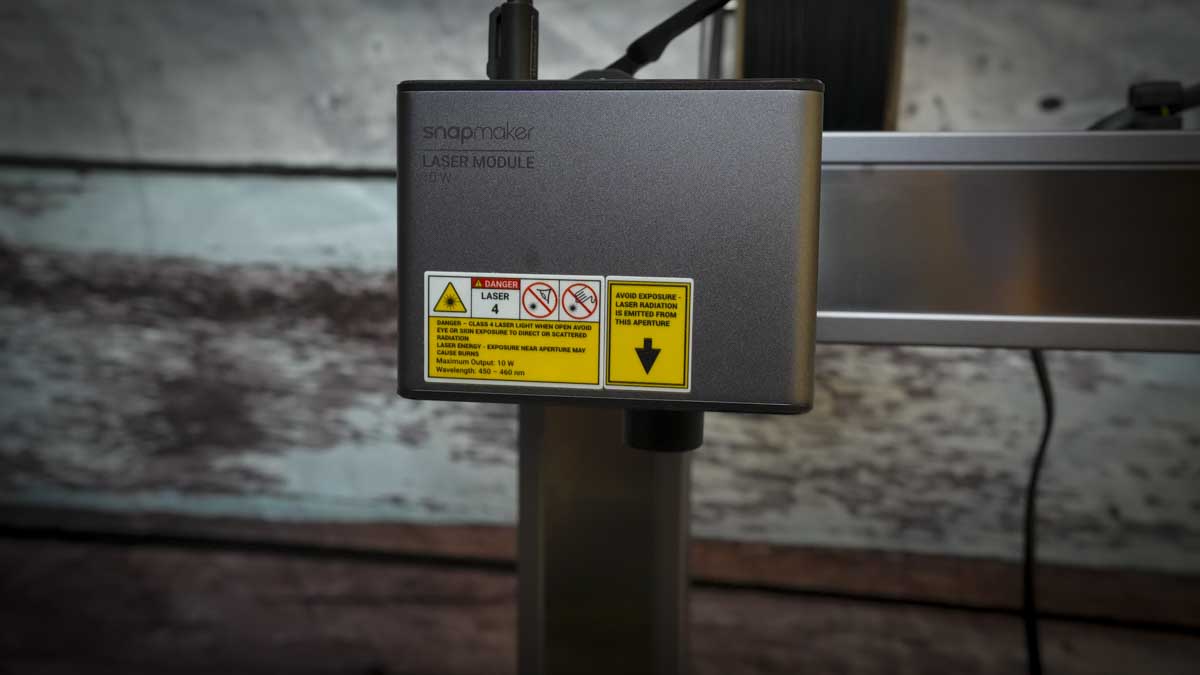
While the Snapmaker Artisan is unique when it comes to features, the basic bed slinger design, at least when it comes to 3D printing, will be very familiar to most. Although from the outset, the build quality and materials are far removed from your average 3D printer. The main construction is all high-quality aluminium alloy, and rather than traditional belts or lead screws, Snapmaker's metal belts are used for motion control; these not only keep things neat when it comes to the look and style of the machine but also aid with accuracy. The build, once initially constructed, which takes around 30 minutes to an hour, results in one of the most solid large-scale 3D printer machines out there, with the bonus that it has two other functions.
From the outset, Snapmaker's work on redeveloping the tool-changing mechanism from the design of Snapmaker 2.0 has to be mentioned. It's incredibly simple, with a quick release on the tool head enabling the module to be removed before the new one is slotted into place and locked; then, it's just a case of switching over the data cable. When it comes to the base, the process is similar, with a quick-release mechanism used to remove the base and slot in the matching one for the tool head you're using. When swapping out the 3D print platform, the power cable needs to be removed, but again, this is quick, and the other two bases don't actually require any connection other than being secured into the machine. This modular design enables you to swap between 3D printing and laser engraving to CNC quickly. It's worth noting that as soon as the tool module and base are swapped, the machine and software, once powered on, will recognise the new modules, and you're ready to go.
Taking a closer look at the modules and functions of the machine we can start with the 3D printing module. This is designed along the usual bedslinger cartesian mechanics, the Artisan includes a large work area of 400mm x 400mm x 400mm, enabling it to print far larger projects than most desktop printers.
Next up is the 200W CNC carver module, again a significant upgrade over the previous 2.0 model. The high spindle speed and linear modules enable the precise machining of materials such as hardwoods as well as some soft metals. However, you do need to swap bits for those different materials, which is done with the simple chuck mechanism, which is loosened and tightened with the two spanners that are included in the box. The CNC module is partnered with a dedicated wooden work surface with holes that enable you to attach clamps that help to keep the materials in place.
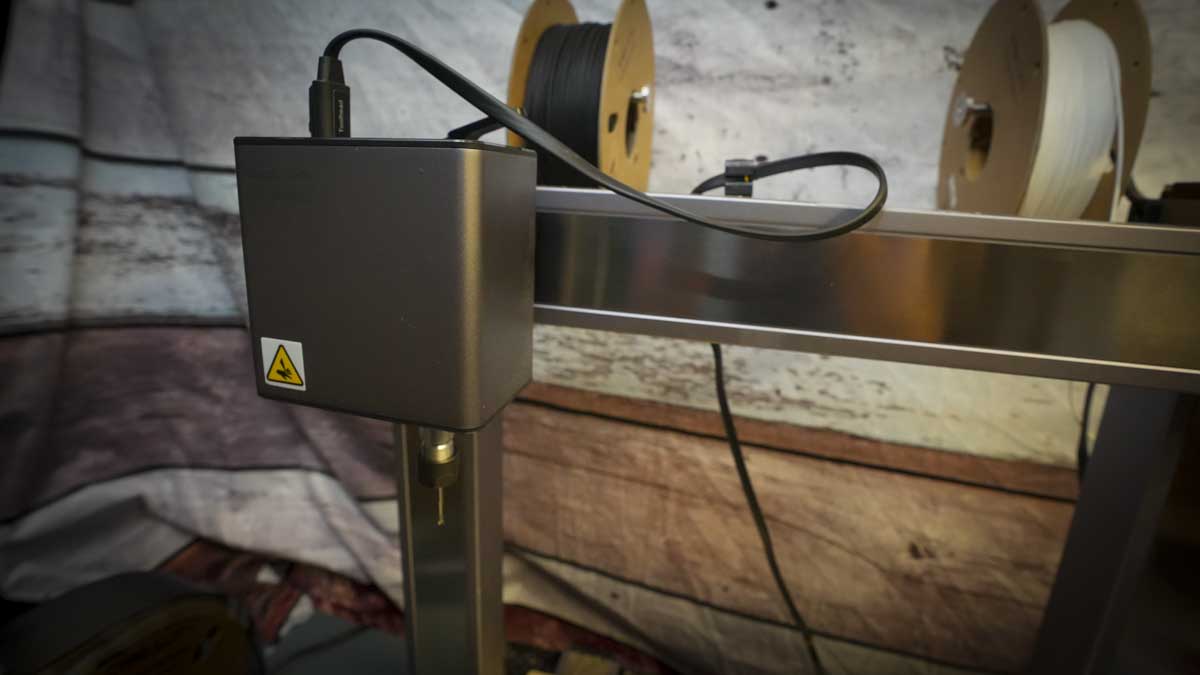
Finally, the laser engraving module rounds up the trio and offers a decent 10W laser module, which is a big improvement over the 1.6W module found in the Snapmaker 2.0 - there's also 20W and 40W aftermarket upgrade options (the 40W comes standard with the Artisan Premium Edition), which will be appealing to anyone looking at this ability as the main focus for the machine. The 10W module can handle a wide range of materials, from wood and leather to acrylic and metal (engraving, not cutting), enabling loads of creative possibilities and making this an ideal machine for anyone working on small to medium-scale production as well as personal work. Again, the laser module is partnered with its base, in this case, a dedicated metal grill work surface and the large safety enclosure, which helps to reduce laser hazards from Class 4 to Class 1. This also means that this machine with the enclosure and an extractor attached can be used in a far wider range of locations as it adds to the machine's safety.
When using the laser engraver, you should use the enclosure, as this enhances safety and reduces smoke, dust, and fumes compared to the other two modules. The enclosure includes door-detection sensors that halt operations when opened, ensuring safety. An extractor isn't included with the machine, but there are plenty of options available.
The final part of the design is the control module, which sits separate from the machine and features a large 7-inch touchscreen interface that provides easy access and navigation to settings and enables you to monitor progress. The information on the screen changes depending on the module you have attached at the time.
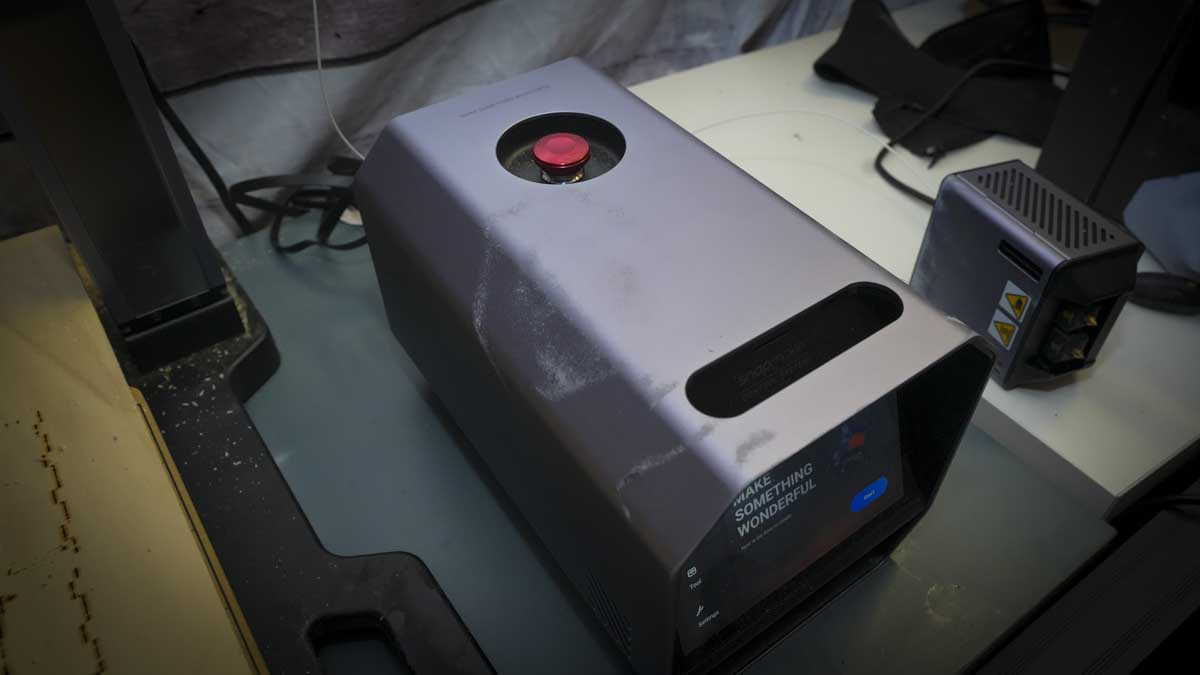
Snapmaker Artisan: Features
Print Technology: Fused Deposition Modeling (FDM), Laser Engraving, CNC Carving
Build Area: 400mm x 400mm x 400mm
Minimum Layer Resolution: 50 microns
Maximum Layer Resolution: 300 microns
Dimensions: 580mm x 620mm x 634mm
Weight: 35kg
Bed: Heated, dual-zone (110°C inner, 80°C outer)
Print Surface: Double-sided (glass and PEI-coated)
Software: Snapmaker Luban
Materials: PLA, ABS, TPU, PETG, wood, leather, acrylic, metal
Print Speed: Up to 180mm/s
The Snapmaker Artisan is packed with features, and while much of the core design looks the same as the Snapmaker 2.0, although much bigger, there have been many significant updates. When it comes to 3D printing, Snapmaker has opted for a dual extrusion system rather than a single, and both the laser and CNC module feature a power boost to 10W and 200W, respectively.
The machine is big, and a standard desktop or even worktop surface will need help to accommodate its pure scale. During the test and without the enclosure installed, the machine sat on an Ikea Linnmon / Adils desk, which, with the machine placed centrally, started to bow under the weight, so something far more substantial is worth considering.
The Artisan features a large build area of 400mm x 400mm x 400mm, which is able to accommodate larger projects than typical desktop printers, with the only real competitor of this size being the Original PRUSA XL, which is a very different machine when it comes to use. Interestingly, Snapmaker has opted for a dual-zone heated bed, which can heat the inner zone to 110°C and the outer zone to 80°C; this helps with energy efficiency and speeds up the printing process as there's less base to get up to temperature. This bed, combined with the double-sided build plate that features a glossy glass side and a PEI-coated side, ensures decent adhesion, although you can't help but feel a sprung steel PEI sheet would have been a more up-to-date solution.
Further enhancing its 3D printing capabilities, the Snapmaker Artisan includes quick-swap hot ends, making maintenance and material changes straightforward. The machine supports a wide range of materials, including PLA, ABS, TPU, PETG, and wood PLA, with a high printing temperature of up to 300°C. This versatility allows users to tackle various projects, from everyday items to more specialised prints requiring specific material properties. At the heart of all three uses is the Snapmaker Luban software that enables you to layout projects and settings easily.
A quick, two to three-minute swap over of modular parts and the machine transitions to laser engraving, with a moderately powerful 10W laser module with advanced beam-combining technology. This feature enhances engraving and cutting capabilities, enabling the machine to handle a wide array of materials, such as wood, leather, acrylic, and soft metals. One interesting feature to note is that the laser module has a high cutting speed, which is capable of reaching 20mm/s for 3mm basswood, which is good if time is short and you want to turn around projects quickly. The wide-angle camera integrated into the laser module captures the entire work area. It gives you real-time previews as the work is produced, which is then shown through the Luban software and enables accurate positioning.
Safety is a critical consideration in laser engraving, and the Snapmaker Artisan includes a safety enclosure that reduces laser hazards from Class 4 to Class 1. The control box next to the machine has an all-important emergency stop button.
Finally, for CNC carving, the Snapmaker Artisan features a 200W CNC module with high spindle speeds of up to 18,000 RPM. This power and speed enable precise machining of a wide range of materials, including hardwoods, acrylics, some soft metals, and carbon fibre. The dedicated wooden work surface and clamps all help to ensure that workpieces are securely held in place.
As with the other modules, the CNC Toolhead features a quick-swap design, enabling easy switching between the machine's 3D print, laser, and CNC functions.
Snapmaker Artisan: Performance
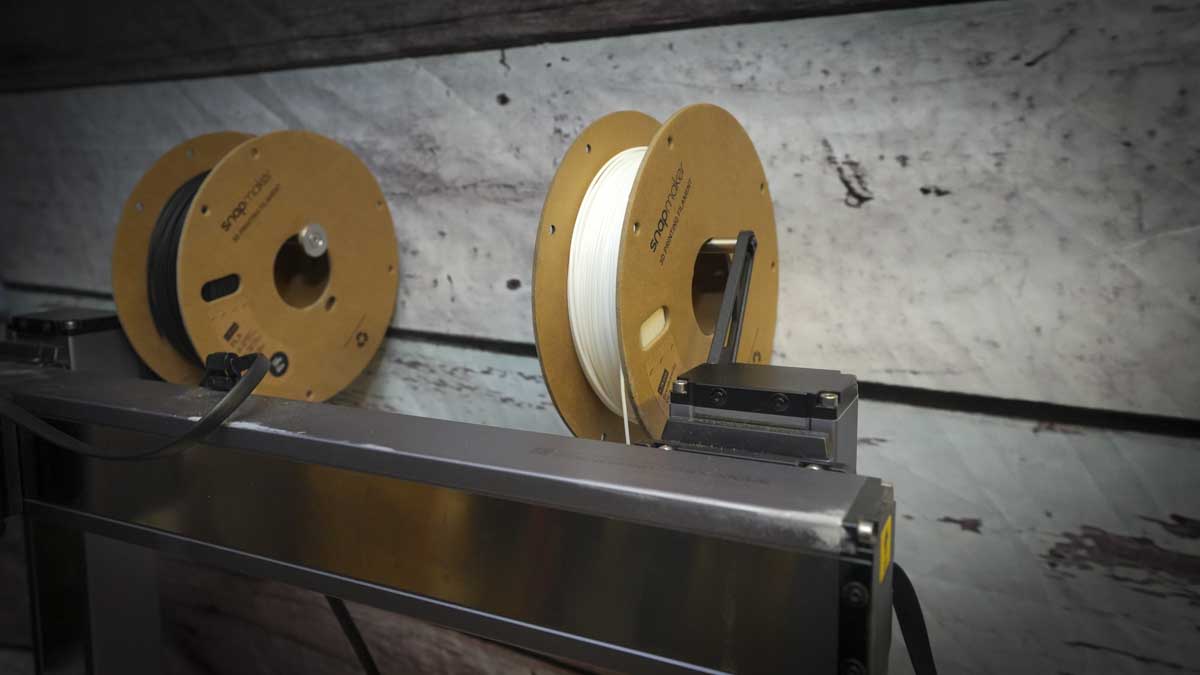
3D Printing Setup and Use
Starting with the 3D print tool head and base, and the initial setup is straightforward. Essentially, with the machine off, the dual filament 3D print head is slipped into position and connected. Then, the heated bed is installed; this is the only base of the three modules that requires a wired connection to the control panel. The whole process should only take a couple of minutes; it's extremely quick and easy.
Once in place, the dual extrusion system allows for multi-material and multi-colour prints, with quick-swap hot ends enabling easy maintenance and material changes. The materials are all selected in the Luban software and applied to the models before printing, and it is just about as intuitive as 3D printing software gets. Loading and unloading materials are relatively straightforward and straightforward, but it's worth noting that it's easier to use the machine without the large enclosure. If you do have it installed, you're going to need a dedicated space for the setup, not just a work surface work surface.
In use, the dual extrusion tool head works well with the absolute accuracy that we saw with the Snapmaker 2.0. The accuracy and finish of the models are good, and compared with the latest competition from AnyCubic with the Kobra 3 and the Creality Ender-3 V3, the quality compares well. However, it's worth noting that the speed of this machine is quite a bit slower than the latest crop of printers.
Another point to note is that while the bed is large, the heated bed utilises a zone-heating design. This means that the printer actually gets up to temperature relatively quickly compared with some other larger-scale printers, although that varies depending on the ambient temperature.
One issue that we did have was with the double-sided glass build plate. While this offers excellent adhesion, once you're used to a sprung steel build plate, it isn't easy to go back to something so fixed and solid.
Overall, the quality of the prints, both single and dual extrusion, is excellent. However, it's worth considering that compared to the latest crop of printers the Artisan will have a slightly longer print cycle than you would expect.
Laser Engraving Setup and Use
Switching over to laser engraving is, again, easy. The quick-swap modular design enables you to unplug the 3D printing module and base before the 10W laser module and base are slotted into place. Unlike the heated bed, the laser base doesn't require a wired connection, but you do need to ensure that the enclosure is installed.
Once the machine is switched on, the laser setup takes a few minutes. The calibration card for the laser and camera performs various checks —it's all quite straightforward. A handy feature is the wide-angle camera integrated into the head. It helps capture the entire work area, providing a real-time preview that helps with the layout of designs on materials. This is a relatively common feature but essential for serious work to ensure that everything is laid out correctly.
Starting with some simple engraving, the 10W laser makes short work of wood and plastic. However, a little more time is needed to adjust the settings for softer metals such as Aluminium. Again, the accuracy of the laser really stands out, with detailed lines and a quality engraving of the material with sharp, defined edges. However, while the enclosure is essential, its size makes the machine quite difficult to navigate and manouver the materials unless you have a good amount of space around the machine.
In use the 10W laser can cut through materials such as 3mm basswood plywood. However, it does take some time, and there are far more powerful lasers out there. However, if you don't mind a bit of a wait, the quality and accuracy of the cut are exceptionally good.
The laser module's performance is good. The speed and power are a little slow, but the quality of the finish is excellent so it does balance out.
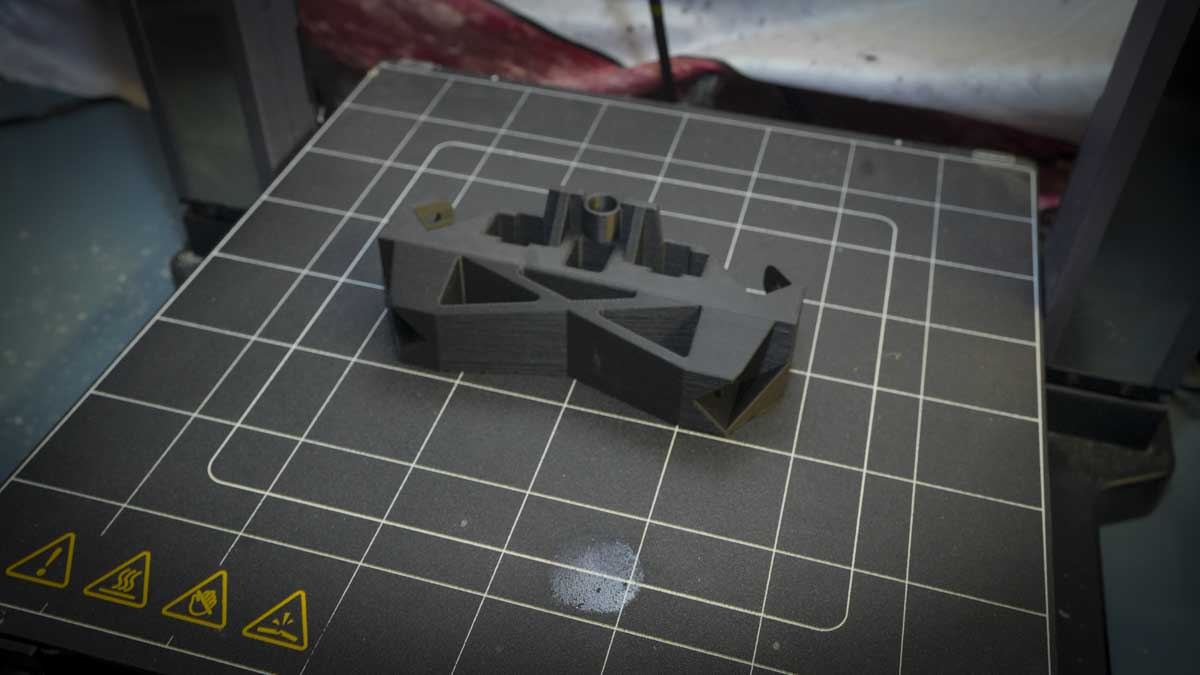
CNC Carving Setup and Use
CNC carving is the lesser-known of their three functions. While there are plenty of laser and 3D print machines to compare, it all becomes a little more tricky with CNC. However, as with the Laser module, the CNC module locks into place, and again, the quick-release base plate for the laser is swapped out quickly for the CNC option.
Once the module is installed, it needs to be calibrated. This is surprisingly easy and takes a couple of minutes to complete. Once done, you can get started with laying out your own designs. Using the built-in tools within Luban, you can lay out your work, again, in a similar approach to using the laser module. Once you're ready to get going, you can use the touchscreen display to set the machine into action.
The CNC feature is surprisingly easy to use, and after some time cutting shapes into wood and plastic, you realise that there's plenty of scope for creativity. However, the 200w does feel a little underpowered, and while it copes with intricate detail, it would have been nice if it could have dealt with some more heavy-weight metals, even if it was just a thin 3mm sheet. Still, considering this is a 3-in-1 machine, the CNC abilities are impressive and, once again, easy to use thanks to the Luban software.
The Snapmaker Luban software is at the heart of the system and enables you to interact with each of the machine's modules and uses. What's really nice is the consistency of the software interface through the use of each different function. This makes it easy to get to grips with maker techniques that you might not otherwise be familiar with.
The other part of the system is, of course, the large 7-inch touchscreen that sits by the side of the machine at all times. This enhances the experience, making it easy to navigate through different settings, monitor progress, and make adjustments as needed.
Snapmaker Artisan: Final verdict
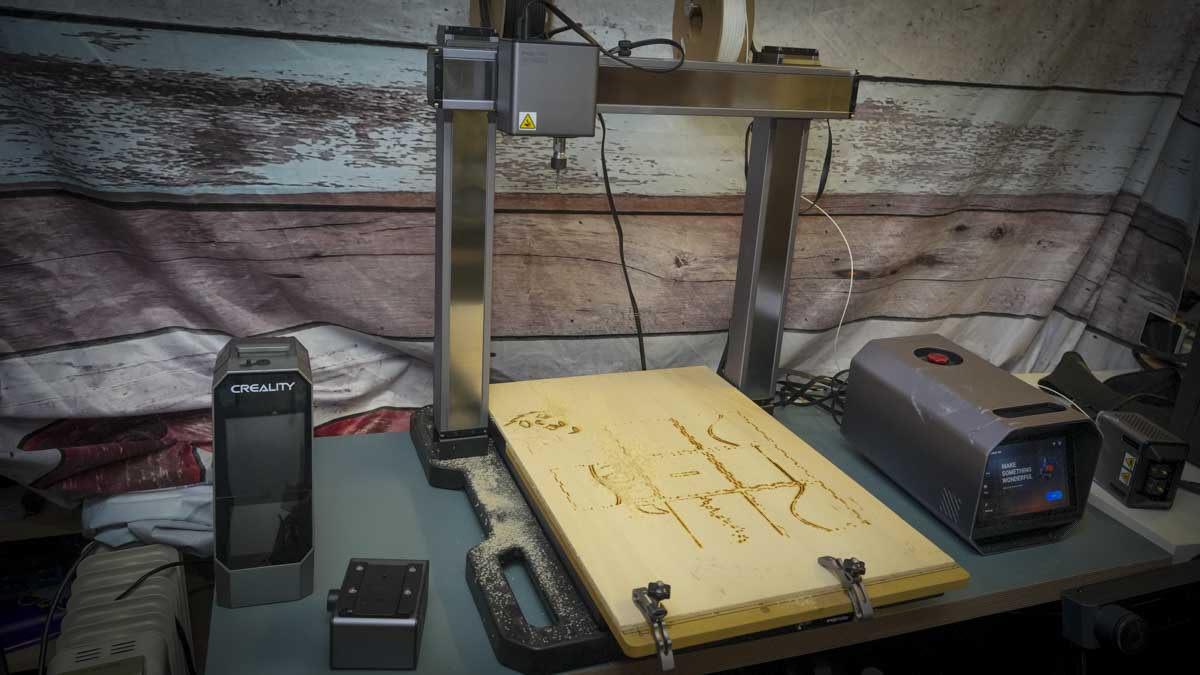
The Snapmaker Artisan is an innovative 3-in-1 machine that builds on the functions, features, and size of the Snapmaker 2.0 and enables you to print 3D, do laser engraving, and do CNC all on one machine. For all three modules and uses, the high precision really stands out, and while the machine might not be the fastest compared with dedicated options, it still goes at a decent pace.
This quality for each use can, in part, be put down to the solid build quality and user-friendly interface, especially the superb Luban software. While the initial cost is high, the versatility and performance of the Artisan do justify the price, especially if you need all three machines and are short on space.
While the Artisan saves you space compared with three large machines, it is huge, especially with the enclosure. While our test workshop has space, even there, it wasn't easy to find an area that was large enough to accommodate the entire setup.
However, once you find a permanent home for the Artist, whether you're a hobbyist looking to explore new creative ideas or a professional in need of a 3-in-1 machine, the Snapmaker Artisan is a great choice.
Should You Buy the Snapmaker Artisan?
For more digital arts and crafts, we reviewed the best 3D modeling software.
0 comments:
Post a Comment